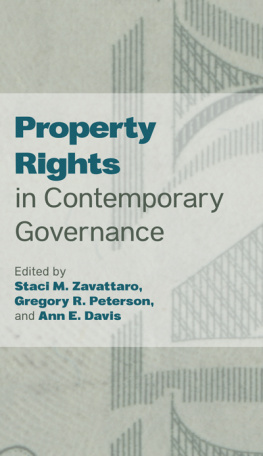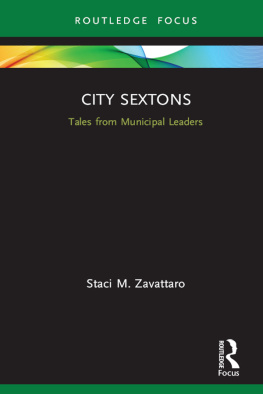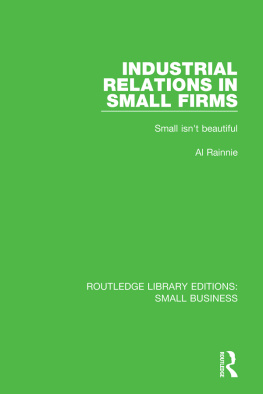Published by State University of New York Press, Albany
2013 State University of New York
All rights reserved
Printed in the United States of America
No part of this book may be used or reproduced in any manner whatsoever without written permission. No part of this book may be stored in a retrieval system or transmitted in any form or by any means including electronic, electrostatic, magnetic tape, mechanical, photocopying, recording, or otherwise without the prior permission in writing of the publisher.
For information, contact State University of New York Press, Albany, NY
www.sunypress.edu
Production by Ryan Morris
Marketing by Anne M. Valentine
Library of Congress Cataloging-in-Publication Data
Zavattaro, Staci M., 1983
Cities for sale : municipalities as public relations and marketing firms / Staci M. Zavattaro.
p. cm.
Includes bibliographical references and index.
ISBN 978-1-4384-4681-3 (hardcover : alk. paper) 1. Municipal governmentPublic relationsUnited States. 2. City promotionUnited States. I. Title.
JS344.P8Z386 2013
352.7'482160973dc23
2012024544
10 9 8 7 6 5 4 3 2 1
Preface
T ake a moment to click over to the city of Ankeny, Iowa's, Web site (www.ankenyiowa.gov). Then try the city of Reno, Nevada (www.reno.gov). Next, visit the cities of Anaheim, California (www.anaheim.net), then Coral Springs, Florida (www.coralsprings.org). Similarities certainly emergebright (and like) colors, logos, social media links, news feeds, attractive graphics, etc. Cities such as these are not unique in the United States. Cities, getting caught up in market models of governance that have ushered in different organizational values and cultures, turn toward more and more promotional activities aimed at shaping and socially constructing their images. Why? Market models naturally bring about competition, and cities do not want to lose valuable economic or human resourcesresidents, visitors, tourists, business owners, city employees, families, seniors, children, teensto their competitors.
Those few cities cited above fall within a pattern of municipalities acting as public relations and marketing firms, adopting and adapting values and mechanisms of self-promotion normally relegated to the private sector. The metaphor, naturally, draws parallels between the public and private sectors, further revealing how lines between the two are increasingly blurring. Organizational communications remains one area left relatively unexplored when critiquing and examining market models' influences within public administration; this book aims to fill that gap. The metaphor I offer of municipalities as public relations and marketing firms answers some questions regarding impacts on public administrators but also brings up questions for further explanation and testing.
For some, the metaphor might cause uncomfortable thoughts and feelings regarding the direction of city promotion. Cities are monopolies, so once people settle there, competitive needs are erased, right? Well, sure, but the competition to attract economic and human resources begins long before people settle in (or visit) a place. Place promotion continues once people have settled (or visited, or opened a business, or commuted to work) in a city, to cultivate and maintain positive relationships with people. Hence, there is the need for marketing to pull people in, then public relations to build on and maintain that relationship.
It is no secret that public sector employees are just as savvy as private sector counterparts when it comes to place promotion. The metaphor takes promotional responsibilities out of the hands of external convention or tourist boards and places them squarely upon the city organization itself. Examples throughout the book, therefore, focus on city developed marketing and public relations campaigns. Specialized staff create the public relations and marketing campaigns; these people have many titles, including public affairs specialist, communication officer, media relations specialist, or public information officer. No matter the title or incarnation, the essential functions remain the sameput out public relations and marketing materials in the name of attracting stakeholders and engendering brand loyalty. Moreover, city staff at all levels, not only those whose duties are directly related to communication and marketing, take on promotional duties in everyday jobscleaning buildings, collecting bills, maintaining parks. In this sense, cities, then, are no different than corporationseach wants to attract stakeholders who stick around for a while (and tell their friends!) to bolster the organization's bottom line.
How cities sell themselves involves six tacticsbranding, media relations, in-house publications, use of outside people or organizations as PR surrogates, aesthetic and affective appeal, and built environment via sustainability. Now, city public administrators must utilize the tactics meaningfully for them to count toward inclusion in the category of a city acting as a public relations and marketing firm. What does meaningfully cover? Essentially, it is a degree and regularity concern. Putting out a press release every few months, for example, does not make the tactic one the city uses meaningfully. Simply describing a program, such as, say, public art or recycling, does not constitute a sales tactic, either. Cities, when undertaking promotional activities, utilize punchy, sales-based, often personalized (you) language, appealing directly to current or potential customers (to borrow language often used in cities employing market models of governance). Therefore, not all cities are considered public relations and marketing firms. There must be purposeful, sustained attention paid to image generation.
A city utilizing all six tactics is what I term a fully realized PR and marketing firm, taking every opportunity to promote its place brand. That said, one might view the degree of tactic use on a sliding scale. On the left would be no tactics or one tactic used. On the right would be all six. A city, should it want to utilize this book as a how-to guide, must determine the accurate marketing mix for its audience. Different stakeholders require, naturally, different campaigns and language. A city might decide, for example, to utilize three tactics in the framework consistently. Or the city might utilize no tactics. Or all six. There is no right or wrong. Cities, though, must be wary of implications of place promotion.
Implications of the metaphor reveal that a city, especially one focused largely on place promotion rather than information provision, may risk alienating its public, thus stifling the critical organization-public relationships. Ideally, organizations of all types want to build symbiotic, mutually beneficial relationships with all stakeholders, understood as those people with an interest in a location. A city focusing on image, rhetoric, and sloganeering could cause its stakeholders to believe that no genuine dialogic communication does or could take place. Interaction runs the risk of turning into a simulationa ritualized, institutionalized practice meant for image-based appeasement rather than genuine organizational growth, learning, and progress.
Plan of the Book
The remainder of the book is dedicated to building the foundation for the argument. Each chapter can be considered a building block, but one does not have to read them sequentially to understand the use and implications of the municipalities as public relations and marketing firms metaphor. gives an overview of organizational communication, public relations, and marketing, especially within the public sector.













